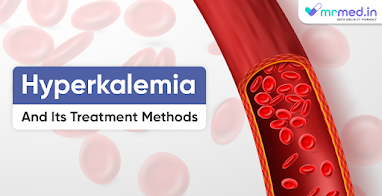Hyperkalemia and its treatment methods
A medical disease known as hyperkalemia is characterized by very high potassium levels in the blood. A vital electrolyte, potassium, is essential for the healthy operation of the heart, muscles, and neurons. However, when potassium levels rise too high, it can interfere with the heart's typical electrical activity and cause potentially fatal consequences.
The average range for normal blood potassium levels is 3.5 to 5.0 milliequivalents per liter (mEq/L). A potassium level over 5.0 mEq/L is commonly referred to as hyperkalemia.
Medicines: Several medications, including ACE inhibitors, angiotensin receptor blockers (ARBs), nonsteroidal anti-inflammatory medicines (NSAIDs), and potassium-sparing diuretics, can raise potassium levels.
Overconsumption of potassium: Hyperkalemia can result from too much potassium, especially in people with compromised kidney function.
Acute tissue damage: The release of potassium into the circulation can result from severe burns, traumatic injuries, or illnesses that cause cells to degrade quickly.
Mild cases of hyperkalemia may not show any outward signs of the condition. But as potassium levels increase, people could experience:
A weakened or paralyzed muscle.
Abnormal heart rhythms.
Vomiting and nauseous.
Uneven pulse.
Feeling tingly or numb.
Hyperkalemia treatment aims to reduce blood potassium levels and avoid life-threatening consequences. Many treatment options are available depending on the extent of hyperkalemia and the patient's general condition. Typical strategies include:
In cases of severe hyperkalemia, intravenous calcium can assist in preserving the heart and stabilize electrical activity. Calcium gluconate or calcium chloride are two options. It does not, however, cause potassium levels to drop.
Glucose and insulin: Insulin aids in the transport of potassium from the bloodstream to the cells. To aid in this movement, intravenous insulin, and glucose are frequently given.
To facilitate the transfer of potassium from the blood into the cells, sodium bicarbonate can be administered intravenously.
Diuretics: Loop diuretics can be used to promote potassium excretion through the urine, such as furosemide.
Medications like sodium polystyrene sulfonate (Kayexalate), which binds potassium, can help the body eliminate extra potassium through the stools. K Bind powder is a drug belonging to the class of potassium binders, containing the active ingredient Calcium polystyrene sulphonate. It is used to treat hyperkalemia.
Hemodialysis: In severe situations, hemodialysis may be required to remove too much potassium from the blood, particularly when other treatments are ineffective, or the patient has kidney failure.
It is significant to remember that hyperkalemia should only be treated with the guidance of a trained healthcare practitioner. Get quick medical help if you think you or someone else may have hyperkalemia.



Comments
Post a Comment